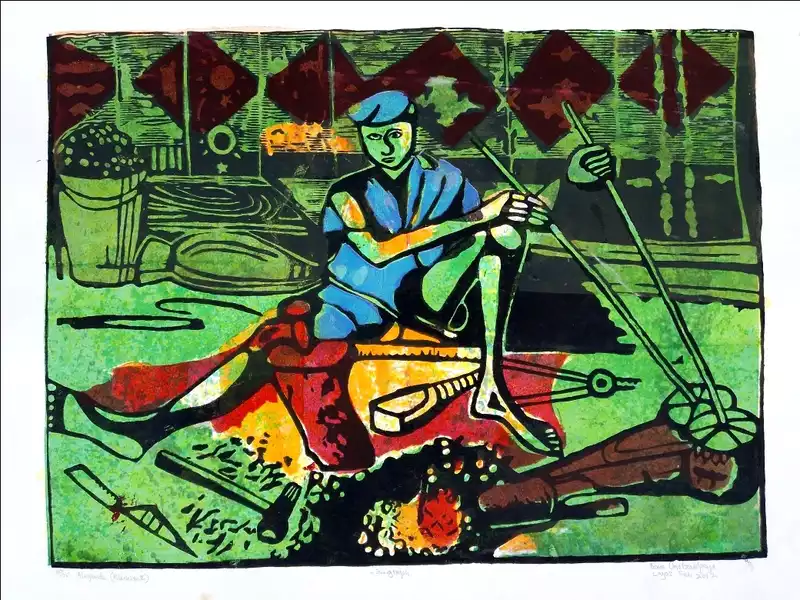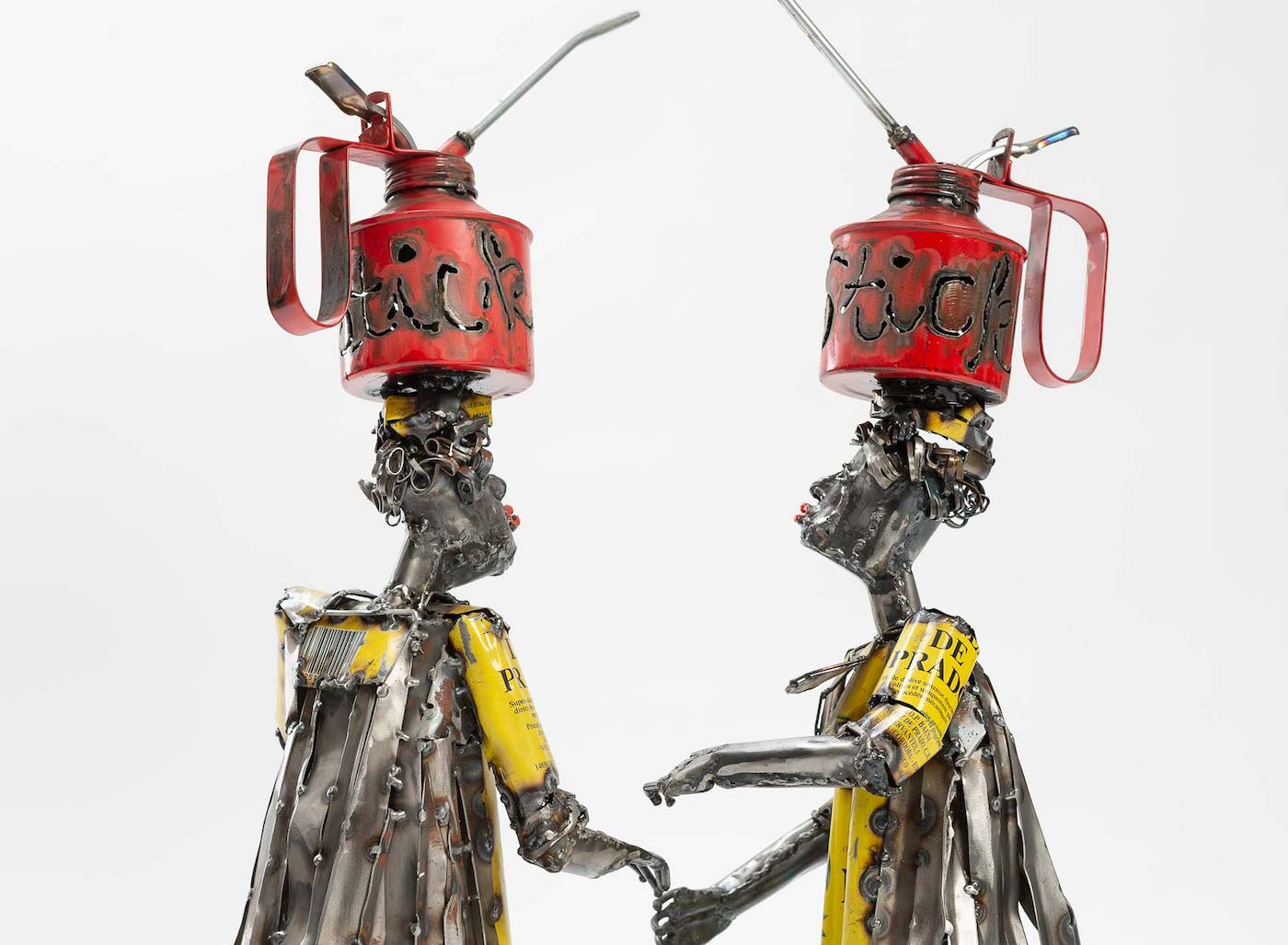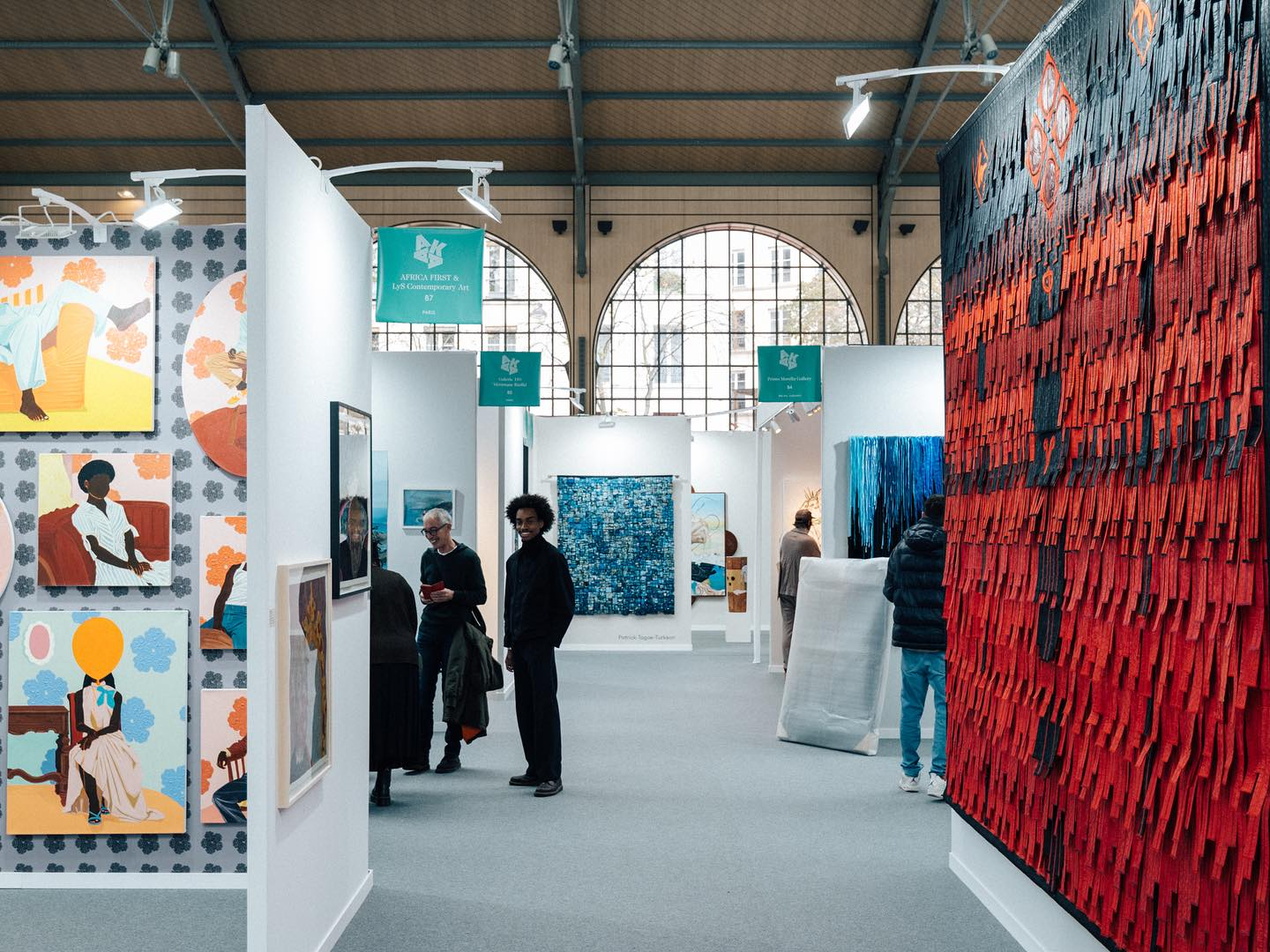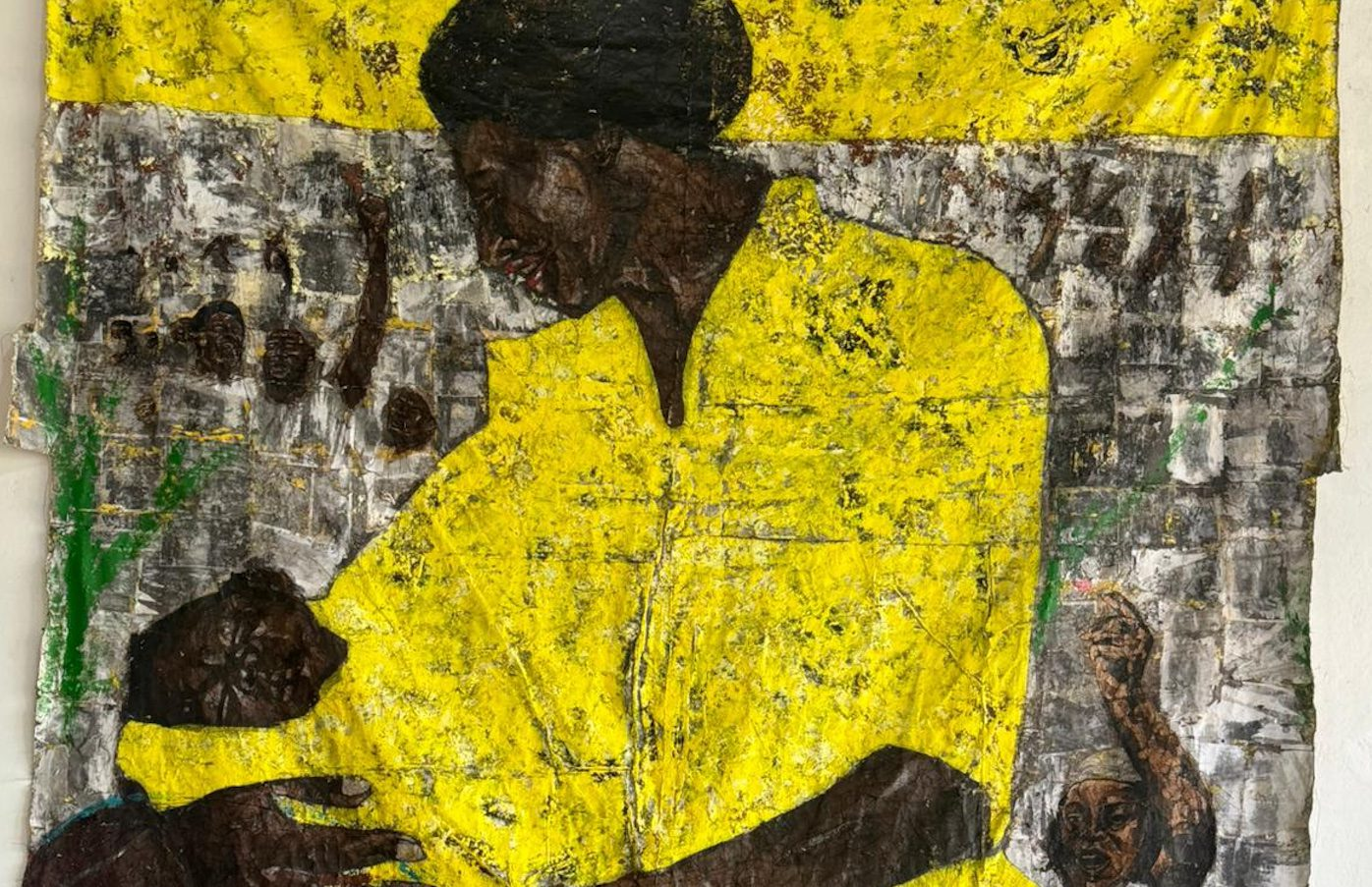Based in Doula, Cameroon, Bwo Gallery is the newest contemporary art gallery in the Central African art scene. On the 2nd of September, 2023, Brice Yonkeu and Noelle Mukete-Elhalaby opened the doors of the latest gallery in Cameroon to the public.
Before co-founding Bwo Art Gallery in 2023, Cameroonian natives, Brice Yonkeu and Noelle Mukete-Elhalaby had co-founded Bwo Art, an Atlanta-based advisory firm that specializes in dealing contemporary African art globally and in managing the careers of contemporary African artists from the diaspora.
The co-founders of Bwo Gallery, Brice and Noelle, spoke with Omenai about the need to support artists on the continent, building a space to promote dialogues between Cameroon and the rest of the world, as well as their roles as advocates for Cameroon in the international art market scene through Bwo Art, the advisory firm, and the -ongoing- inaugural exhibition of Sesse Elangwe’s works.
Courtesy of Bwo Art Gallery.
Tell us about Bwo.
Noelle Mukete-Elhalaby: Bwo is an art gallery in Douala, Cameroon that focuses on contemporary art from Africa and its diasporas. It aims to foster cross-cultural exchanges with the world, showcasing emerging and established artists through solo and group exhibitions.
At Bwo, how do you intend to promote and support the artistic production of contemporary artists from Africa and its global diaspora?
Noelle: We want to be very intentional when executing the work of the artists we collaborate with but intention only does not justify an artwork nor does execution on its own.
Our goal is to showcase artists that express bold perspectives with impactful delivery. These artists are usually deeply connected to their values, cultures, and surroundings. However, they may not always fully grasp how their work is received across different societies and sometimes, time or era. And here’s where we come in, to show our audience how to appreciate the elements that transcend the artists’ artistic intentions and to also elevate their art beyond mere objectification.
We’ve been blessed because owning Bwo Art, our art advisory and artist management business, for 3 years has put Brice and me in a space of cross-cultural exchanges. We have been exposed to a large network of gallerists, collectors, and artists and this has enlightened us on originality and the intricacy of contemporary art, especially ones by African artists. So, through our programming and the exhibition opportunities we will offer, we want to foster cross-cultural exchanges between Cameroon and the rest of the world by creating opportunities for artists to connect with diverse audiences, art professionals, and collectors.
We’re also growing our online presence to extend our reach globally. Through our social media, we plan to connect Contemporary African artists with art enthusiasts, collectors, and curators worldwide.
You launched three years ago in Atlanta as an artist management and art advisory company. What informed your decision to transition into a gallery?
Noelle: “Bwo Art” is actually separate from “Bwo,” the art gallery. We want our gallery to be simply known as “Bwo,” while our artist management and art advisory company that launched 3 years ago remains known as “Bwo Art.”
So, Bwo Art has facilitated the sale and placement of over 150 artworks in prestigious private collections across Africa, Asia, Europe, and North America. Through its extensive network, the company has supported numerous exhibitions for its artists, nurturing their growth and establishing vital connections within the art world.
We’ve always been big advocates for Cameroon, Africa, and its diasporas and we needed to open a physical space that will enable us to achieve our goals in a bigger capacity, and what better way than to open an art gallery?
Brice Yonkeu: Our decision to transition into a gallery felt like a logical next step which was on the one hand motivated by the extensive network we have built with artists, collectors, and curators over the years, but also and mainly by a need we identified: the lack of contemporary art galleries to support artists on the continent.
By launching Bwo, we aim to support artists, nurture homegrown talents, and create opportunities for more engagement with contemporary art through a consistent program. Traveling the world as an art advisor, one is often astonished by how easy it is to access the works of artists who look like us in Europe or North America. Thus, inspired by the incredible efforts and initiatives of some peers in West Africa, we wanted to expand the offer and make it possible (and known) that it is possible to exhibit on the continent in spaces that respect international standards and could give similar resonance to a body of work.
Lastly, being a curator, having my own space gives me more freedom to engage through art in conversations and collaborations that I and the team find meaningful and relevant.
Courtesy of Bwo Art Gallery.
What are your thoughts on the development of the art scene in Cameroon, and more generally Central and West Africa? With Bwo in the mix, what does the future look like for the art market in Cameroon, and in the Diaspora?
Noelle: We cannot deny that Cameroon has a rich history of cultural excellence. In fact, renowned artists like Pascale Marthine Tayou, Barthélémy Toguo, Hervé Youmbi, Samuel Fosso, and Bili Bidjocka come from Cameroon. Even recognized curators like Koyo Kouoh, Simon Njami, Bonaventure Bejeng Ndikung and Marie-Ann Yemsi are Cameroonian natives. This somewhat proves that there is undeniable potential that Cameroon holds to break into the art scene.
However, there is a noticeable scarcity of opportunities for the local artists and the local population of Cameroon to connect with the tangible aspects – in this case, art – of our national heritage and culture. I believe Central Africa as a whole is facing the same issue as us compared to our neighbor, Nigeria, for example, which seems to be growing quite rapidly in the art scene. It’s also important to note that the future of the art market in the region and the Diaspora will depend on the continued support and recognition of African art, as well as the efforts made to address the challenges.
With Bwo coming into play, we want to create a more inclusive art ecosystem in the region. We will foster dialogue, collaboration, and knowledge-sharing within the local and global art community.
For the gallery opening, you presented Sesse Elangwe’s latest body of work in a solo exhibition titled ‘The Defiant Ones.’ Could you tell me more about the work and the curatorial concept behind it?
Brice: This exhibition is Elangwe’s debut solo in his home country Cameroon. To mark this, he felt compelled to create a body of work that represents how he feels and what he thinks as he now navigates between his home country, and the United States. As an artist whose statement stresses the importance of knowledge acquisition and self-development to strive individually and collectively as Black people, Elangwe decided to create this collection of 13 paintings (including a diptych) titled “The Defiant Ones”.
The paintings depict figures using a surreal and intense dark pigmentation, in revelatory moments and scenes where they realize the importance of adopting a defiant attitude towards life in order to surmount the obstacles and structures meant to confine us. Elangwe created these paintings using as basis reference shots of people staged in different areas of his hometown, Buea, that marked him. On “Tell Me Another Story”, a female figure is depicted in the middle of Malingo Street in Buea, firmly holding a bag, ready to take on any life-changing opportunity. In another painting “The Allegory of Knowledge”, a reinterpretation of a biblical scene of Adam and Eve in the Garden of Eden, a couple is picnicking but this time around, it is the male subject who beholds the artist’s signature large eye of enlightenment representing knowledge that feeds the female subject with closed eyes an apple. Besides the impactful visuals, messages, and symbolisms of this series, what strikes viewers the most is the immense level of detail and execution which solidifies Elangwe’s position as an incredible painter and artist of our time.
Sesse Elangwe, The Allegory of Knowledge (2023).
Courtesy of Bwo Art Gallery.
With your years of experience in the African art scene, in Cameroon and the diaspora, could you describe what your experience building new relationships with artists, curators, and collectors in the art world is like?
Brice: I believe that like-minded people attract each other. Over the years, I have come to understand that the art world might seem big by the mention of “world” but in reality, it is quite small. Noelle and I are mostly drawn to people whether artists, curators or collectors who share similar interests to ours, mainly that of supporting or putting at the forefront artists with undeniable talent and authenticity in their expressions, as well as fostering conversations that help understand the plurality of perspectives and realities about the African continent, Blackness, and artistic practices. At a global stage, it’s a long-term agenda with multiple steps to carry out, but at the continent’s or micro level, there seems to be a consensus and willingness to act, which makes it easier to build relationships be it friendly or professional.
What does the current programming look like for Bwo Art? Any idea what it will look like in the next 3 years?
Brice: For this first year, our focus is on curation. We intend to present the works of artists we truly believe in or simply artists whose works will resonate with our local community of art enthusiasts here, in the boldest way possible. Art should provoke transformation, at a personal level or collective level, we are excited about the prospects of these transformations with our viewers both online and offline, as well as the direction that the artists will take showing with us.
Lastly, one thing Covid-19 has taught us all is that force majeurs are very real. We can’t talk about a 3-year plan yet, but we hope within this timeframe to participate in art fairs, and why not stage off-site exhibitions?
Please share one or two art book recommendations that guide and inspire your practice as a curator.
Brice: This is a very tough question as what I read or what guides me often varies according to the exhibition I am curating.
For Sesse Elangwe’s current exhibition at Bwo, for instance, ‘A Black Gaze: Artists Changing How We See’ (2021) by Tina Campt, and Kerry James Marshall’s exhibition catalogue ‘The History of Painting’ with essays by Teju Cole guided and inspired me. They provided me with references but also helped me confront certain notions or concepts.
However, as a self-taught curator, at the end of the day I realized that what works best for me is a mix of many things and that curating is about observing, listening, reading, writing, and staging.
Iyanuoluwa Adenle is a Nigerian art writer, essayist, and poet based in Lagos. She is currently the head writer at Omenai. Adenle has contributed to a number of art publications, including Tender Photo, Art News Africa, Pavillon 54, and Omenai.






